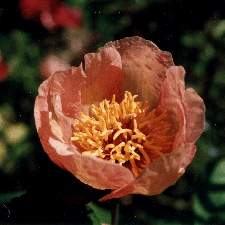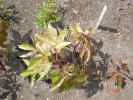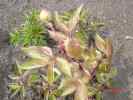FAN TAN (History p.113) FAN TAN (Introduced in this country by Louis Smirnow) Originated by a Japanese physician in Japan, 1954. Parentage unknown. Known as AUREA, also YOKIHI. Semi-double flower, apricot tan, suffused yellow. Large petals tipped slightly pink. Early. Bulletin #216.
FAN TAN (APS 1976-85, p. 10) FAN TAN - Introduced in this country by Louis Smirnow. Originated by a Japanese physician in Japan. Known as Aurea, also Yokihi (1954). Parentage unknown. Flower, semi-double. Apricot-tan suffused yellow. Large petals tipped slightly pink. Early.
does not seem to be identical with the following:
AUREA (Imported from Japan by Smirnow) - Double - Yellow - Bulletin 123, Page 21.


Walter Good (on Y!groups 2004):
Since some years this exciting peony is growing in my garden. I got it from a nursery in Austria. Can any body tell me the parents of this herbaceous hybrid?
Reiner Jakubowski
Dear Walter,
Fan Tan was registered by Louis Smirnow in 1975. The registration write-up gives about as much information as was ever written about this cultivar. Chris Laning had some by June, 1975, and Raymond Scheele mentions it in his article published in September, 1974. This all suggests that Fan Tan was reasonably well known before it was ever registered, but with the lack of information in the Bulletin, knowledge of it probably came from Smirnow's catalogues. Unfortunately Smirnow rarely (if ever) published parentage or originator information (if he knew it in the first place) and so we are left guessing.
Below are excerpts from the APS Bulletins, beginning in 1951. This is because the names AUREA and YOKIHI, which are attributed to Fan Tan, were also attributed by Smirnow in his 1974 registration of ORIENTAL GOLD, but he makes no mention on this in his earlier 1954 ORIENTAL GOLD registration. Reiner Jakubowski
--------------------------
December 1951, No. 123, pg. 21, in "The Medal Winners" by W. F. Christman · Mr. Smirnow has imported from Japan a variety AUREA, that is said to be full double yellow. It has never bloomed here yet. Some of us are looking forward to seeing it next year. Let us hope it will be the long sought after yellow.
December 1952 No. 127, pg. 14, in "Peony Notes, 1952" by George Peyton · Several new ones have come from Japan. There are nine of these in my garden. None of them are old enough to give good bloom. Some of them should this year. One of them is supposed to be a double all yellow. There seems to be two different varieties of this, though they have been sent over under the same name, AUREA. One of the plants had golden yellow roots and looked unlike any peony roots I ever saw. The other had roots like our regular lactiflora varieties. The one with the yellow roots was labelled both AUREA and YOKIHI, the latter being the Japanese name I suppose.
September 1954, No. 134, pg. 32, in "Dept. of Registration" · The following variety, whose name has been approved by the Nomenclature Committee, is presented for registration by the owner of the stock in this country: Louis Smirnow, 8 Elm Court Drive, Sands Point, Long Island, New York.
ORIENTAL GOLD (Japan, 1954). D. M. Y., Parentage unknown. Probably a herbaceous hybrid. Roots yellow. Stems upright, strong, bright green, medium tall. Foliage slightly darker, small. Flowers medium in size, double with some hidden stamens, lemon yellow, fading lighter with age. It blooms with the late Japs. It should prove good for landscape work, arrangements and hybridizing. Due to the fact that the origin of this variety is unknown and also its true name is uncertain, it is being registered by Mr. Smirnow under the above name.
June 1963, No. 169, pg. 48, in "Recommended List of Varieties" by Marvin Karrels · ORIENTAL GOLD (Japan about 1950) D. M. M. Pure lemon yellow. (This has been imported under several names, among them AUREA, GOLDEN DREAM, and the really correct Japanese name YOKIHI. Nothing definite is yet known of its species or origin.)
March 1974, No. 209, pg. 41, in Peony Registration · ORIENTAL GOLD (Louis Smirnow) Species Double, Parentage unknown, bloomed first 1959. Yellow, ball form. No stamens, good substance, one bud per stem, pollen, no fragrance. 33-36 inches in height, bright green foliage, blooms midseason. Good stem strength and vigorous. I brought this in, from Japan in 1960. As seedling, there it was known as YOKIHI, also as AUREA. Have since introduced plant here and in countries in Asia, Europe, South America, Australia, and New Zealand. Registered by Louis Smirnow, Jan. 16, 1974.
September 1974, No. 211, pg.10, in "Lou Smirnow - Man of the Peony Past and Future" by R. L. Scheele · Two of his introductions, Oriental Gold and Fan Tan, represent significant color contributions to herbaceous peonies. The former rewarded Lou's long search for a yellow herbaceous, while the latter provides the unusual combination of apricot-beige suffused with yellow, and edged in delicate pink. (Both these varieties may also prove of long botanical interest. Oriental Gold may represent a mutant or a new species, according to Dr. George Morel who is said to have attributed a 10 chromosome count to the plant. The several hues marking Fan Tan blooms are ordinarily a Lutea trait, not found in the herbaceous group - suggesting the possibility that this, too, may be a mutant or a new species).
December 1975, No. 216, pg. 32, in "Department of Registration" · FAN TAN (Introduced in this country by Louis Smirnow) Originated by a Japanese physician, in Japan. Known as AUREA, also YOKIHI. (1954). Parentage unknown. Flower, semi-double. Apricot-tan suffused yellow. Large petals tipped slightly pink. Early.
Reiner Jakubowski
The earliest reference to Fan Tan I could find, copied from a Smirnow catalogue. There was never a date on any of Smirnow's catalogues, so no idea of the year. It was after 1971
NEW HERBACEOUS PEONY
We are pleased to introduce a new herbaceous Peony, perhaps a new species. This is a distinct new color and, like our introduction Oriental Gold, should result in the possible creation of a new race of Peonies.
FAN-TAN. This is the Japanese description: "Color is apricot-tan, suffused yellow. An unusually large single to semi-double, very large petals tipped slightly pink. Appearance resembles Paeonia obovata but leaves set from the bottom of the stem and short petioles. It is the earliest Peony to bloom. It is an artistic novelty of great beauty " We have a few for sale. Will be scarce for years. $20.00 NET.
Dick Westland
Dear All
Couple of months ago some members wrote about Fan Tan. Some had purchased this hybrid from Miely. I have bought one too and this year it was the first time in flower. It appears to me that this plant is very identical to Mai Fleuri. In fact I think that both are the same plants. The plants are both typical Lemoine Wittmanniana Hybrids. The picture of Fan Tan on the website of Miely could be with some imagination quite identical to Mai Fleuri. The flower doesn't show much of the "apricot color" and is not at all like the "overcoloured" picture from Mr Smirnow's" catalog (I have one of these catalogs) Now there are a couple of things that could have happened.
Miely accidential sent me the wrong plant or my Mai Fleuri is Fan Tan, but this plant comes from a very old dutch collection even before the time Fan Tan was introduced Miely's source seems to be the Klose nursery and as I recall the late mr Klose had contacts to Mr Smirnow during the fifties/sixties.
Of course it also can be that Mr. Smirnow was fooled by a japanese nursery. (by accident or on purpose).
From personal correspondence with Mr. Laning I have learned that he tried very hard to cross Fan Tan but never had any seed of it.
Prof. Saunders also tried very hard to cross the Lemoine-Wittmanniana Hybrids but all failed.
So if Fan Tan is in fact Mai Fleuri it would explain why Fan Tan is highly sterile.
My question is if any one of the members was able to compare Fan Tan to Mai Fleuri and did have the same thoughts.
Greetings Dick Westland Netherlands
M.S. Uspenskaja 2003, p. 142:













